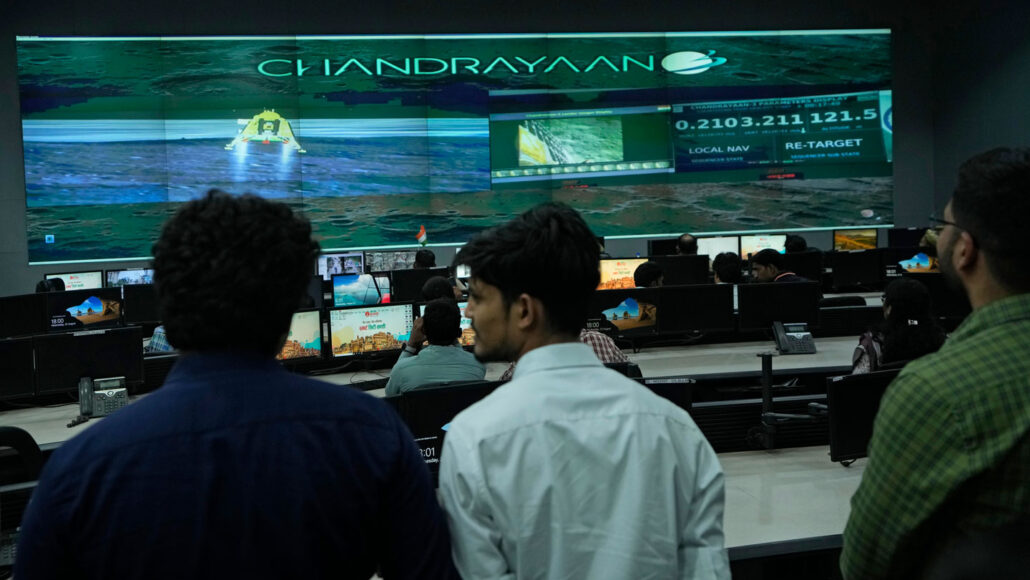Other countries face recent failures as India achieves successful moon landing

Space is hard, as the saying goes.
As humans have endeavored to launch themselves and their machines beyond Earth, that maxim has been proven again and again. Recent attempts to touch down on the moon — a feat first accomplished nearly 60 years ago by the former Soviet Union’s robotic Luna-9 probe — have been particularly fraught with failure.
But on August 23, an Indian spacecraft, for the first time, successfully landed on the surface of the moon.
The Chandrayaan-3 mission, which launched July 14, delivered the Vikram lander and the Pragyan rover to the south pole of the moon, a region thought to contain water ice (SN: 5/24/22).
Such reservoirs of water ice would provide a crucial source of not only drinking water for any future lunar inhabitants but also hydrogen for fuel. This was the country’s second attempt at a lunar landing, following the crash of Chandrayaan-2’s lander in 2019 (SN: 9/20/19).
Vikram’s landing catapults India into a rarefied group of nations that have successfully made a “soft landing” — as opposed to an uncontrolled “hard landing” — on the moon: the United States, the former Soviet Union and China (SN: 12/16/19). The success of the mission, however, follows close on the heels of recent failures.
On August 19, Russia’s Luna-25 lander crashed into the moon. The car-sized spacecraft had been orbiting the moon for several days when, according to Russia’s space agency, communications were lost after the craft fired its engines during prelanding maneuvers. Luna-25 was bound for the vicinity of Boguslavsky crater near the moon’s south pole, where it would have studied the moon’s surface and tenuous atmosphere.
Earlier this year, on April 25, Japan’s Hakuto-R Mission 1 lander also crashed on the moon’s surface. According to ispace, the private company that developed the mission, the crash occurred because onboard software miscalculated the lander’s altitude above the lunar surface. The lander was slated to touch down in Atlas crater on the nearside of the moon and study lunar dust.
Despite its relative proximity of just under 400,000 kilometers, the moon is a challenging target for spacecraft seeking to land (SN: 4/11/19). That’s in large part because our nearest celestial neighbor lacks an atmosphere.
The go-to mechanism for slowing down a descending object on Earth — a parachute — is therefore useless, says Dave Williams, a lunar and planetary scientist at NASA’s Goddard Space Flight Center in Greenbelt, Md. “The only way to slow yourself down is with rockets.” That’s where things get tricky, he says, since firing a rocket means controlling its orientation and thrust, among other things.
The moon’s gravity, while only roughly one-sixth that of Earth’s, is strong enough to have a deleterious effect on a crippled spacecraft in free fall, Williams says. (Spacecraft landing on a comet or asteroid have it easier because those bodies’ gravitational fields are generally so weak there’s little danger of a crash.)
There’s also the challenge of determining a safe landing site. An area that appears smooth as seen from orbit might in fact be littered with boulders or other obstacles, Williams says. A spacecraft’s software must be capable of evaluating the terrain on its own.
Relying on human operators back on Earth isn’t feasible, Williams says, because there’s too long a lag in communications due to the finite speed of light. “You’re always 2.5 seconds behind.”
Get great science journalism, from the most trusted source, delivered to your doorstep.
Even so, the moon remains an appealing target, and on August 26, Japan will try again. The country’s space agency is slated to launch its Smart Lander for Investigating Moon, or SLIM, mission from the Tanegashima Space Center. No landing date has been announced, but if all goes well, the probe — designed as a technology demonstration — will eventually touch down near Shioli crater on the nearside of the moon.
Our mission is to provide accurate, engaging news of science to the public. That mission has never been more important than it is today.
As a nonprofit news organization, we cannot do it without you.
Your support enables us to keep our content free and accessible to the next generation of scientists and engineers. Invest in quality science journalism by donating today.




